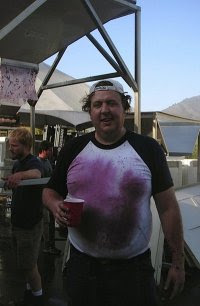
Smack bang in the middle of harvest I needed to fly back to Australia as part of my Wine Science degree to stare at microbes under a microscope for four days.
Microbes are a very important part of a winery. Of course, wine is made through the action of our favorite friend,
Saccharomyces cerevisiae or wine yeast, which converts sugar in the berries into ethanol (alcohol) and CO
2. There are also other friendly microbes like
Oenococcus oeni that help give red wines and many Chardonnays their soft mouth-feel.
However there are also many nasty bacteria and yeasts that if given a chance would love to screw up your wine. The most well known is a family of bacteria called
Acetobacter that converts ethanol into acetic acid - more commonly known as vinegar! Not only is this a major wine fault but it is also very noticeable since acetic acid is what we call volatile - in other words it likes to leave the wine as a gas and thus is picked up by our nose very easily. Acetic acid is also often converted through some other chemical reactions into Ethyl acetate which smells of nail polish. Tasty! So next time you have a glass of wine that you think might not quite be "right", stick your nose in and see if it is because of a vinegar or nail polish taint. If it is you can say damn those nasty
Acetobacters!
So what can a winemaker do? Luckily, for us
Acetobacters need O
2 to survive and once fermentation by our wine yeast (you remember our friend
Saccharomyces cerevisiae) is underway enough CO
2 is given off to kill any
Acetobacters. But before and after fermentation we need to be very careful. This means after crushing the grapes, the must (winemaker term for the juice and skins) needs to be covered with a blanket of CO
2 at all times until fermentation is happily chugging along. After fermentation it means keeping all the barrels topped up with wine and during bottling it means that we need to flush the bottles with an inert gas like Nitrogen or Argon so there is no O
2 in the ullage (winemaker term for space between the wine and the cork/screwcap) that can let
Acetobacters get a foothold when your wine is happily sleeping in the cellar.
All of these nasties mean that we spend a lot of time keeping things clean in the winery. In fact, for each hour of what you might term "romantic winemaking" there are three hours of washing up. Its all worthwhile though to ensure that your next glass of vino doesn't smell like yesterday's salad dressing or your overly made up Aunt Ethel!
 Once fermentation is underway, we punch down the cap twice a day. Our little friends, Saccharomyces cerevisiae, are chomping away on grape sugars and turning it into ethanol, CO2 and heat. The CO2 that is released pushes the grape skins to the surface and the heat "bakes" the skins into a soft cake that we call the cap. Above you can see that half the tank is punched (look at all that creamy goodness bubbling up - thats CO2 coming up) and the other half is still caked.
Once fermentation is underway, we punch down the cap twice a day. Our little friends, Saccharomyces cerevisiae, are chomping away on grape sugars and turning it into ethanol, CO2 and heat. The CO2 that is released pushes the grape skins to the surface and the heat "bakes" the skins into a soft cake that we call the cap. Above you can see that half the tank is punched (look at all that creamy goodness bubbling up - thats CO2 coming up) and the other half is still caked.








